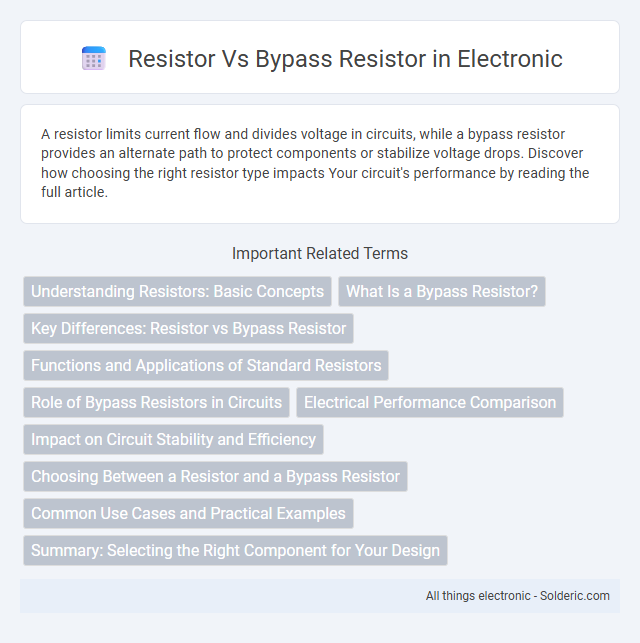A resistor limits current flow and divides voltage in circuits, while a bypass resistor provides an alternate path to protect components or stabilize voltage drops. Discover how choosing the right resistor type impacts Your circuit's performance by reading the full article.
Comparison Table
| Feature | Resistor | Bypass Resistor |
|---|---|---|
| Primary Function | Limits current and drops voltage | Shunts current around a component or section |
| Typical Use | Voltage division, biasing, current limiting | Maintain circuit operation when a component fails or for parallel current paths |
| Placement | Series with the load or signal path | Parallel to the component or circuit branch |
| Resistance Value | Varies widely depending on application | Usually low compared to main resistor for effective bypass |
| Impact on Circuit | Controls current flow and voltage drops | Provides alternative path to protect or stabilize circuit |
| Failure Mode | Open resistor stops current, may interrupt circuit | Ensures continued operation despite component failure |
Understanding Resistors: Basic Concepts
Resistors regulate electrical current by providing a specific amount of resistance measured in ohms, essential for controlling voltage and current in circuits. A bypass resistor is a specialized resistor connected in parallel with another component, typically to provide an alternative current path and stabilize voltage or reduce noise. Understanding their distinct roles helps optimize circuit performance, balancing power dissipation and signal integrity.
What Is a Bypass Resistor?
A bypass resistor is a component used to redirect current around a specific part of a circuit, typically to protect sensitive elements from voltage spikes or to maintain circuit stability. Unlike a standard resistor that limits current flow throughout the circuit, a bypass resistor provides an alternate path, ensuring your electronic device operates smoothly under varying electrical conditions. Understanding its role can improve circuit reliability and performance in applications such as LED drivers and power regulators.
Key Differences: Resistor vs Bypass Resistor
A resistor limits current flow and adjusts voltage levels within an electrical circuit, while a bypass resistor specifically provides an alternate path for current to improve circuit performance, often in LED drivers or speaker systems. Bypass resistors reduce voltage drop or signal distortion by diverting excessive current around sensitive components. Understanding these key differences helps optimize your circuit design for efficiency and stability.
Functions and Applications of Standard Resistors
Standard resistors regulate current flow and divide voltage in electronic circuits, ensuring precise control of electrical parameters. They are commonly used in applications such as signal conditioning, biasing active elements, and setting time constants in filters. Unlike bypass resistors, which provide low resistance paths to maintain stability in amplifiers by reducing noise, standard resistors primarily manage current and voltage for functional circuit operation.
Role of Bypass Resistors in Circuits
Bypass resistors play a crucial role in stabilizing voltage and preventing signal distortion in electronic circuits by providing an alternate path for current around sensitive components, such as capacitors. Unlike standard resistors that primarily limit current, bypass resistors enhance circuit performance by minimizing voltage fluctuations and noise interference. Your circuit's reliability and signal integrity improve significantly with the strategic use of bypass resistors in filtering and biasing applications.
Electrical Performance Comparison
A standard resistor primarily limits current flow and drops voltage based on its resistance value, providing predictable power dissipation in circuits. In contrast, a bypass resistor is used in parallel with a component, like a capacitor or transistor, to stabilize voltage, reduce noise, and improve transient response by minimizing signal distortion. Electrical performance comparison highlights that bypass resistors enhance circuit stability and frequency response, whereas standard resistors focus on steady-state current control and power regulation.
Impact on Circuit Stability and Efficiency
Bypass resistors enhance circuit stability by providing a low-impedance path for high-frequency signals, reducing noise and preventing oscillations, whereas standard resistors primarily control current flow and voltage levels. Using a bypass resistor can improve your circuit's efficiency by minimizing power loss and voltage fluctuations, crucial in sensitive analog or RF applications. Proper selection between resistor types directly influences overall circuit performance and reliability.
Choosing Between a Resistor and a Bypass Resistor
Choosing between a resistor and a bypass resistor depends on the desired circuit performance and frequency response. Standard resistors are used for general current limiting and voltage division, while bypass resistors are specifically employed to stabilize components by filtering high-frequency noise and improving transient response. Selecting the appropriate resistor involves analyzing signal frequency, noise levels, and circuit stability requirements to optimize overall functionality.
Common Use Cases and Practical Examples
Resistors are widely used to limit current, divide voltages, or set bias points in electronic circuits, exemplified by their role in LED current limiting and voltage dividers. Bypass resistors, specifically employed to provide alternate current paths, are crucial in noise reduction and signal stability, often found in parallel with capacitors in power supply filters to improve transient response. Practical applications include using standard resistors in series with LEDs for current control, while bypass resistors are commonly used in audio circuits and RF designs to stabilize impedance and enhance signal integrity.
Summary: Selecting the Right Component for Your Design
Resistors provide precise control of current and voltage in circuits, making them essential for setting bias points and limiting current flow. Bypass resistors, often placed in parallel with capacitors, improve circuit stability and reduce noise by shunting high-frequency signals to ground. Choosing the right component depends on your design's need for accuracy versus noise reduction and frequency response optimization.
resistor vs bypass resistor Infographic

 solderic.com
solderic.com